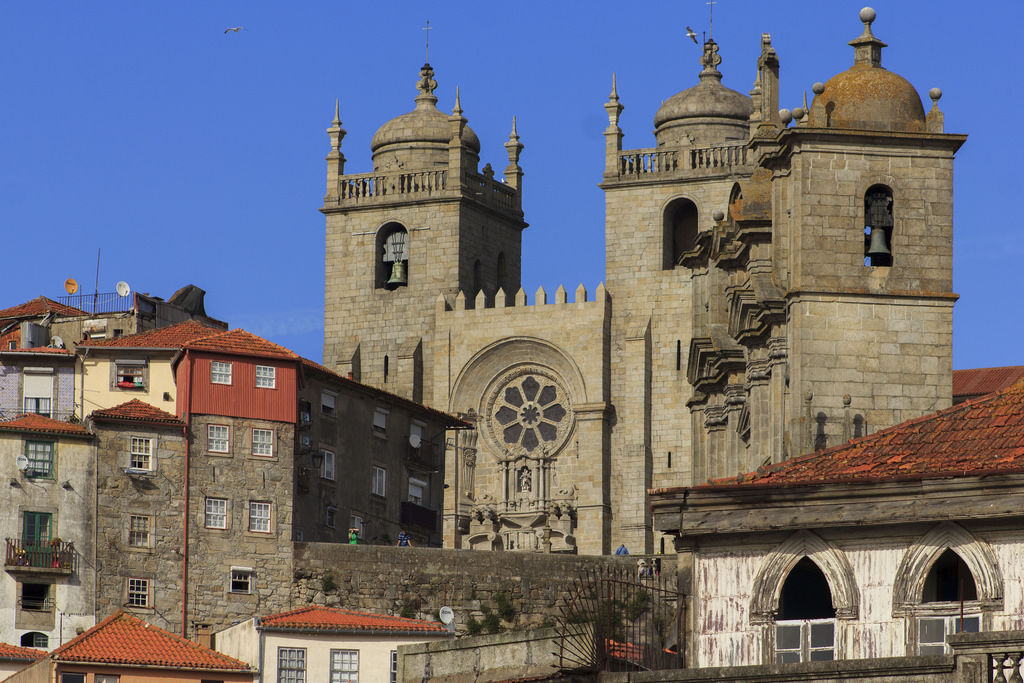About Porto
The city of Porto, known as Cidade Invicta (invincible city), is the second largest in Portugal, the capital of the Porto district and of the country’s northern region. Porto built along the hillsides overlooking the mouth of the Douro River, is an outstanding urban landscape with a 2,000-year history. Its continuous growth, linked to the sea (the Romans gave it the name Portus, or port). It was declared as a World Heritage Site by UNESCO in 1996 and considered the European Best Destination in 2014.
Detailed information about accommodation, public transportation, sightseeing tours, gastronomy, nightlife and culture may be found in the Official Portal of Oporto Tourism and Visit Porto and the North Portal.



Porto Top Attractions
Cais de Gaia (Gaia’s Pier) – The city’s postcard skyline and the birthplace of one of the world’s most famous wines.
Serralves Museum – Two buildings that are as much a work of art as the collections they exhibit inside, surrounded by a magnificent park.
Casa da Música (House of Music) – An architectural masterwork by world-renowned architect Rem Koolhaas.
São Francisco Church – One of Europe’s most extraordinarily lavish church interiors, completely covered in gold.
Ribeira – Atmospheric, colourful, World Heritage riverfront medieval district
Sé Catedral (Porto Cathedral) – The 12th-century fortress-cathedral is located in the heart of the historical center of the city of Porto and one of the main and oldest monuments of Portugal.
Clerigos Tower – Designed by the Italian architect Nasoni, this iconic baroque church is a popular tourist attraction for overlooking the city (76 meters up, after a steep flight of 240 steps)
Palácio da Bolsa (Bolsa’s Palace) – This 19th-century building with a vast Neoclassical front is the former Stock Exchange Palace , where the ornate Arab Room could be mistaken for a royal place.
Dom Luis Bridge – Designed by Gustave Eiffel, this Oporto’s iconic bridge opened in 1886. The lower level can be used by pedestrians to cross the river between the center of Oporto and Vila Nova de Gaia, providing a great Ribeira view and port wine warehouses.
Soares dos Reis Museum – A notable national art museum named after one of the country’s top artists
Porto Top Experiences
Lello Book Store – Go inside the “Lello & Irmão” bookshop, a historic space with a Neo-Gothic interior where J.K.Rowlings inspired herself to write Harry Potter
Majestic Café – Have a drink at “Café Majestic”, a classic European Art Nouveau café and a city landmark
Gigantic Tile Murals – Admire the gigantic tile panels inside São Bento railway station and on the façades of Carmo and Capela das Almas churches
Art Galleries Street – Check out the art galleries down Rua Miguel Bombarda
Time-warp Shops – Shop at the retro shops downtown, many preserving wonderful Art Nouveau façades. Recommended: A Vida Portuguesa and Pérola do Bolhão
The Monumental Heart of the City – Watch the world go by on Avenida dos Aliados
Mercado do Bom Sucesso – An urban concept that combines a fresh market, diversified gastronomic offer (44 stalls colored with a wide variety of gastronomic delights from various Portuguese regions and from other parts of the world) and cultural activities.
Hard Rock Cafe – Located near the vibrant town square, Avenida dos Aliados, Hard Rock Cafe Porto is housed in a high-personality six-story building erected in the 19th century, Combining Porto’s strong sense of history with the irreverence and character of the Hard Rock brand
FC Porto Museum and Estádio do Dragão – The FC Porto Museum traces the history of the football club since its formation in 1893. Estádio do Dragão is a great stage of emotions, entertainment, spectacle, and an unavoidable reference in the sporting and cultural life of the city of Porto.
Palácio de Cristal (Crystal Palace) gardens – This beautifully landscaped park is dominated by a huge domed pavilion built in 1956 which replaced the 19th century iron-and-glass “Crystal Palace” (1865 — 1951), modelled on London’s Crystal Palace and authored by the English arquitect Thomas Dillen Jones. Today’s pavilion serves as a venue for concerts and sporting events.
University of Porto – Faculty of Engineering
The University of Porto (Universidade do Porto) now has a history of just over century. Although it was formalized into its current status in 1911, its roots go even further back into the 17th century in the form of several schools later integrated into the University. In the early days of its inception, the University was comprised of: the Faculty of Mathematical, Physical & Chemical and Historic & Natural Sciences (de Ciências Matemáticas, Físico-Químicas e Histórico-Naturais) and the Faculty of Medicine (Faculdade de Medicina).
Aggregated to the Faculty of Sciences was an Engineering School, which later gained autonomy under the form of the Technical Faculty (Faculdade Técnica). Later reform re-organized the newly founded Faculty into its earliest courses: Civil Engineering, Mining Engineering, Mechanical Engineering, Electrotechnics and Industrial Chemistry. Some of these denominations would survive until the present day, taking part its FEUP’s current broad spectrum of Engineering disciplines which include: three 3 year Bachelor Degrees, nine 5 year Integrated Master’s Degrees (in conformance with the Bologna Process), twelve 3 year Master’s degrees and twenty-two 3 year Doctoral Programmes.
For a more detailed history, visit this page.



